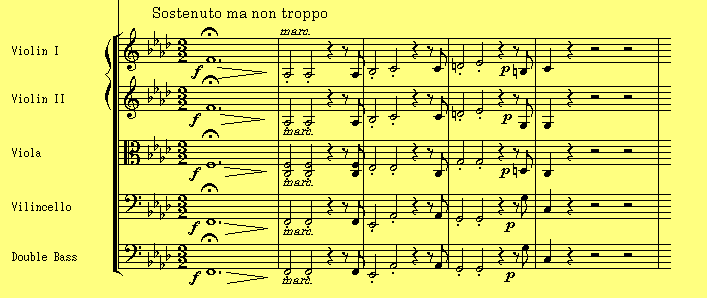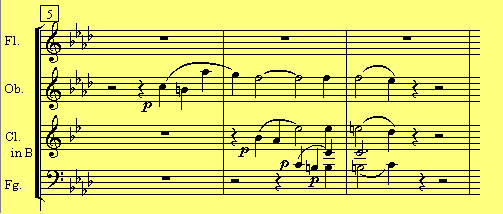 Beginning
Beginning@
Interpretation of gEgmonth Overture
@
PDBefore the interpretation
@I arrange the things that must be done before interpretation. (I quote mainly from a score-commentary of gEgmonth, written by Hiroshi Endo, published from Ongaku no tomo sha corp.)
@
General theme
@The main theme of this work exists in the sympathy with Graf Egmontfs character. He has an indomitable resistance heart that takes root in love to his motherland. And he wanted to bring the matter to an amicable settlement by conference, not by force. He is of a lovable disposition.
@
Meaning of each part
the 1st part introductionF
@It represents Egmontfs fate and outcry of people to save Egmont, etc.
he 2nd part 3/4 AllegroF
@It represents pressure and terror, strong faith and character of Egmont, death of Egmont, pure love of Klärchen, etc. Especially, it is said that the end of the 2nd part represents guillotine. Only T&U violin play strong high C down to G there.
he 3rd part 4/4 Alego con brioF
@It sings spiritual victory after death, and seems to suggest free independence of folkways of het Nederland soon.
@
@There are some important key-words that we should represent in performance.
@the 1st part introduction F gfatehgoutcry
of peopleh
@the 2nd part 3/4 Allegro F gstrong
faithhgdescription of guillotineh
@the 3rd part 4/4 Allegro con brio
F gsing victoryhgfree independence of folkwaysh
@
Characters
@Characters are Graf Egmont, his friend Wilhelm von Oranien, his love Klärchen, Herzog von Alba, and the people. Other characters cannot be specified.
@Graf
Egmont, Prinz von Gaure F
He is a hero that the people respect. He is cool, thoughtful and
courage to sacrifice himself for his nation.
@Wilhelm
von Oranien F
He is a comrade with Egmont. But, he tries to rise in resistance
more violently than Egmont.
@Klärchen,
Egmonts Geliebte F
She is called by her pet name of Klärchen in the drama. She
tries to help captured Egmont bravely. It may be the symbol of
respect of general people for him that she is given the role of
citizenfs daughter.
@Herzog
von Alba F
He is a new governor-general of het Nederland. He is a cruel man
and thinks to suppress peoplefs dissatisfaction by force.
@There are people that are suffering from the oppression and
rebel against it. There is Egmont that wants to reform peacefully
as he appeases the people.
@He presses Alba, but fails. He is imprisoned and is cut by his
neck.
@But then people stand up, acquire the independent, and his
wish is realized. (This part is suggested in the last of the
original work.j
@
QDInterpretation ithe 1st partj
j Italics are dynamic and theory in Italian, Germany or French.
 Beginning
Beginning
@
@
@
@I think there is no need to explain, this impressive
beginning differs a little from the same sound of bar 9.
@There is gff h in bar 9, without fermata or decrescendo.
@What do you read from the difference? This thinking is the
problem to be mentioned here.
@All knowledge must be mobilized to read this point.
@First, you may be shocked so much if you listen to the beginning with gcommon senseh.
@Some intention can be felt if the beginning sounds by harmony. If it sounds by unison of F like this, you will feel something that peals to your body uneasily. Something special just like the cannon of French army that Beethoven heard.
@When it sounds F once more in bar 9, this time it is heard by gff h nearly than the first time. The volume is kept without decrease and go ahead without stop (without fermataj.
@What is intended here?
@The sound of nature decreases naturally like the sound of beginning. It surprises, but has no message.
@The second time, it is suppose to decrease, but it doesnft.
@Therefore I feel the will that implies strong resistance from
the strong sound. This should be the goutcryh of people that
the commentator says.
@Of course you need to know the content of drama gEgmonth to lead a conclusion like this. If you perform unknowingly, the first sound doesnft differ much, but the second sound may be similar.
@Then, why Beethoven gvaried ff in bar 9h?
A doubt is left. The origin of the sound has approached, I think.
@Why he gput off fermata h? The first sound is the beginning, so because it starts in a moment, he didnft want make a stream, I think.
@
@
Melody of beginning with marcart

@The motif from bar 2 is half note with staccato, moreover marcart iclearly one by onej is indicated.
@The first motif of bar 2 has no auftact (Gr.). It is
quite strong representation. Because it is the reaction of
beginning sound, of course.
@That is to say, it may be gthe outcryh of people in anger
toward the oppression.
@The second one of bar 3 has auftact of eight note (τ). Itfs not quarter note (?). Therefore the situation is instituted quite acute. The blank of almost one time before τ raises the tension so high. Afterward the variation of the first one makes sure. The third one of bar 4 goes more upward and expands consent of anger.
@But the fourth one of bar 5, gp h is indicated, is concluded by this short one without passing tone. It may mean a doubt gAber (Gr.) ?h like something uneasy. It is proved following. The second time of bar 9 has no gp hafter gff h. It has been already snapped out of it.
@
Motif of fate
@If you perform you can catch a passage of melody every two bars, further every four bars.
@Therefore τ seems to be an ornament of the next tone ione tone at gp hj, the frame impresses to consist of four tones iAσ, C, Eσ, Cj. Seeing that this is gthe motif of fateh, it can be said gabsolute fateh.
@This gmotif of fateh is known as a material of music since ancient. Whether you donft know that, in our gordinary senseh, four times knocks suggest the coming of fate something special. The sun rises gda, da, da, daaanh. One more or less knocks canft make sense. gThe stream of timeh of nature that people canft oppose is four tones.
@It is possible that this part is gthe uprising of Egmonth, but itfs a mistake.
@In the commentary of literature cited, the writer
says gGraf Egmont loves the people EEE he overestimates
himself and raises an army. But he fails and is captured.h It
isnft faithful to the original. Egmont tries to bring the
matter to an amicable settlement by conference, not by raising an
army. But the governor-general fears his effect on the people,
and captures him and executes him.
@So the theme of this music is praise for his reason to try to stand face to face with the authority by conference. He doesnft reflect upon a danger to his life. The praise is not for a hero that tries to confront by force.
@Therefore this part is the voices of Oranien and people that want him to resist by force.
@Itfs Egmont that appeases them. Following, an oboe plays him.
@If you mistake this recognition for characters first,
everything shifts.
@The present writer mistook first, the story became
inconsistent later.
@,
Melody of woodwind instrument

@The oboe starts to play new impressive melody from the
middle of bar 5. It includes jumping that shows the strong will
which is calm by gp h, however is filled with
confidence. This melody is a modification from gIst das
(Gr.)?h before it. And it suggests acknowledgment, because it
goes down opposite to go upward.
@This part is repeated by other instruments one after another
like an echo. It seems to consent of comrades.
@But Toboe acknowledges once, then has gunspeakable uneasinessh. After jumping of minor 7, it is accompanied by appoggiatura of G in the head of bar 6. However this voice canft be caught in many performances because the other voices of consent cover it.
@In the beginning of bar 7, all tones are suspentions except Tfagotto and the expression is same.
@Though in bar 8, consents comes one after another. The repeat by the violin from bar 7 makes the trust towards him deeper, but the uneasy doesnft melt away.
@It can be said that the courage to confront becomes music with mixing uneasy well.
@Beethoven tries to show the meaning with slur over four or five tones here. A period of two tones means consent gyes, yesh, but it doesnft as it includes a large jump.
@It fits ghoweverh of gI think so, however itfs dangeroush, doesnft it?
@
@
Reappearance from bar 9
@The explanation for bar 9 is done with the beginning, so let me go on to bar 10.
@There is a difference here with bar 2. The formation
differs and all instruments (except the timpani) perform.
@The first time, they accuse Graf Egmont and he replies calmly.
@They seem to gaccuseh to request some deal after consent
here.
@The expression is same with bars 2-3, but there is no gp
h part of the question gIst das (Gr.)?h here. The
consent is once.
@Itfs exactly. The very same repeat of a conversation that is
done yet sounds glengthyh. If there is gp h,
it means something special, for example, in the case to explain
more for the people that donft understand well. Here it makes
the trust between comrades weak.
@The story has gone forward, yet.
@
@